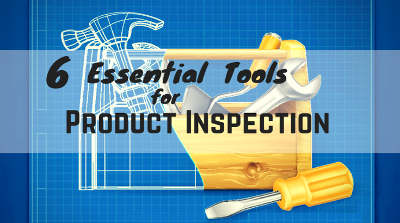 If you're like most buyers, verifying the quality and standards of your products isn't just a priority for you - it's your livelihood! Your personal income and the success of your business are directly tied to the quality of your products and your ability to bring them to the market. When you hire a third-party to inspect your products, you're putting your trust in them. You rely on them to deliver accurate reporting so that you know whether or not your order is ready to ship.
If you're like most buyers, verifying the quality and standards of your products isn't just a priority for you - it's your livelihood! Your personal income and the success of your business are directly tied to the quality of your products and your ability to bring them to the market. When you hire a third-party to inspect your products, you're putting your trust in them. You rely on them to deliver accurate reporting so that you know whether or not your order is ready to ship.
So what is one way you can assess whether or not your inspection company is delivering accurate reports? Take a look at the tools they're using to conduct inspection. If you want to know what a professional QC company should be using for equipment, read on. We'll tell you about six essential tools for every product inspection (Don't forget to check out the podcast on this topic!).
1. Measuring tape for measuring product dimensions
Product inspectors use measuring tape to verify dimensions of the outer shipper carton, retail/color boxes, and the product and its components. A reliable measuring tape should be a durable strip of flexible plastic, fiber glass or metal that can easily be carried in a toolkit. It should have linear measurement markings in both the metric and English system. Measuring tape is generally used to take measurements of larger dimensions, where less precision is needed.
2. Dial calipers for measuring finer dimensions
An inspector uses calipers to measure dimensions with higher accuracy and precision. Calipers are typically used to measure small product components, such as the thickness of a lid, the diameter of a connector or a plug, or the depth of a cup.
3. Camera for documentation
Tools for documenting inspection findings are important for reporting results. It’s important that your inspector provides you with as clear a picture of your order state and status as possible. This way, you’re able to make an informed decision about shipping.
A simple point-and-shoot camera can help clarify particular product defects and other issues uncovered during product inspection. You may receive a detailed inspection report for your product. But without photos included, you may be unsure of what certain defects are or how severe they may be. Photos help you as the buyer to determine whether any issues are serious enough to hold an order from shipping or minor enough to approve the order for shipment.
Equally important, photographs included in the report serve as proof that certain on-site tests were carried out by inspectors. If you’re hiring a third-party QC company to inspect your order, make sure the inspection report includes photos of any testing like assembly or function testing that should have been performed.
4. Defect stickers for marking product defects
Defect stickers are an important tool for marking defective units during inspection and pointing to specific defects. Defective items found during product inspection are generally separated from flawless units and later tallied during reporting. By marking defective units with defect stickers, an inspector is able to keep track of those units that have defects. This also saves the inspector significant time trying to sort out which defects were found on which units. Time saved for the inspector often brings down inspection costs for you, the buyer.
 Also important, a defect sticker helps to indicate to the buyer where a given defect is located on a product. You may see a photo in an inspection report that is followed by the description of a product defect. But if the product photographed doesn’t have a defect sticker, you may need to contact your inspection company for clarification, costing you more time. For this reason, some inspection companies take defect stickers very seriously, even going so far as to print measurement marks on the stickers for easier reference. Defect stickers are an invaluable part of any professional inspector’s toolkit.
Also important, a defect sticker helps to indicate to the buyer where a given defect is located on a product. You may see a photo in an inspection report that is followed by the description of a product defect. But if the product photographed doesn’t have a defect sticker, you may need to contact your inspection company for clarification, costing you more time. For this reason, some inspection companies take defect stickers very seriously, even going so far as to print measurement marks on the stickers for easier reference. Defect stickers are an invaluable part of any professional inspector’s toolkit.
5. Pantone swatch for color comparison
A simple Pantone swatch provides a standard for color comparison during product inspection. Buyers often have requirements for product or packaging artwork that include specific color codes. Pantone swatches utilize a standardized set of color codes known as the Pantone Matching System (PMS). Manufacturers and designers internationally are familiar with this system. Your inspector should carry a Pantone swatch during inspection, particularly if you haven’t provided them with an approved sample for comparison. To learn more about Pantone colors and how they’re used by inspectors, read What are Pantone Colors and How Do We Use Them?
6. Barcode scanner
Verifying barcodes is a basic part of just about any product inspection. Barcodes contain product and distribution information essential to tracking the product throughout the supply chain. Barcodes are so important, in fact, that a buyer will often refuse an entire order if a single barcode is found to be unreadable of inaccurate. QC inspectors rely on barcode scanners to verify barcode validity and accuracy during product inspection. Be sure to provide your inspector with barcode specs and make sure they have a working scanner to use during inspection.
Conclusion
Professional inspection companies carry a lot of gear. Depending on the complexity of an item and the buyer’s requirements, they may need to carry even more. It’s also worth noting that inspectors often rely on the factory to provide certain equipment for particular types of on-site testing. But the following are among the most essential, basic tools that every inspector should bring:
- Measuring tape
- Calipers
- Camera
- Defect stickers
- Pantone Swatch
- Barcode Scanner
Now that you have an understanding of what a professional inspector should have on hand, make sure your QC company is using these six tools during your next product inspection!







